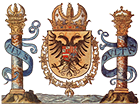Chronicle of an exceptional emperor.
His personality and its signification for Europe today.
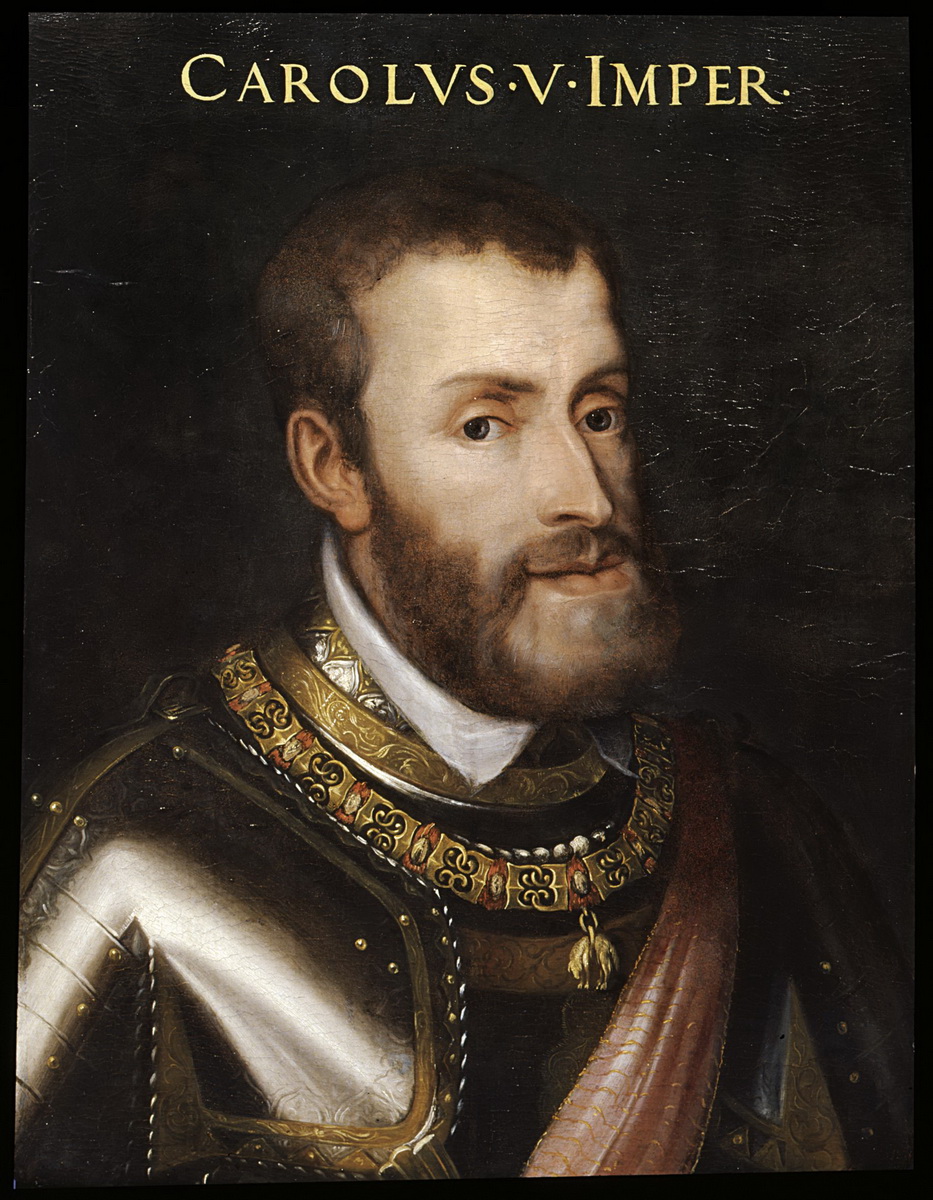
The historical explanation of Charles V's personality is difficult to achieve, although hundreds of letters of the Prince were preserved - usually written by his private secretary – and despite the number of books on Charles V that have been published.
The difficulty of this work is not only linked to the fact that many sources preserved in the archives in Brussels and Vienna, have not been fully exploited, but it is also related to the fact that nearly all the existing documents have not been written with the intention to describe the personality of the prince.
Therefore, it is almost impossible to completely meet the objective of the above mentioned title.
However, we would like to give a personal and human perspective on the figure of Charles V, the most powerful monarch of the 16th century.
In addition to an overview of the most important of Charles V life events, in line with the objectives of our Association, we wanted to make a portrait of the man, on a more substantial way. Find out here another Charles V.
A real man of the 16th century, coming from the best aristocratic circle.
His appearance was certainly impressive when he reached the top of his reign, but when he was young, there was no indicator that under his discretion a great leader was hiding. The boy was frail, he was thin and seemed melancholy. The untimely death of his father and the absence of his mother certainly played an important role.
He had difficulty speaking, he had a lisp and he stammered. He also showed little interest in cultural activities. On the contrary, it is clear that he was fully engaged in his body workout, in horse riding, etc.
Around the year 1530 Charles V had become physically quite mature, with a full beard and the typical features of the Habsburgs. When he was harnessed as a knight, one could admire him in all its finery in his battle armor.
But his eventful life would claim his due. Around 1555, Charles V, aged 55 and after decades of constant travels through his vast empire, was physically quite decrepit and he had various diseases and discomforts.
Socially, Charles was portrayed in rather generous terms with somewhat a mythological dimension. In his personal relations, he was a man rather amiable, sometimes with a few stubborn outputs, but always loyal in friendship. The protocol was an enormous weight for him, he was a bit ironic about the moral and greedy behaviors at his own table and at his guests one. He presented himself as a considerate father with his legitimate children but also with his bastards. He also demonstrated a passion for hunting in the countless forests of his Netherlands, where he tirelessly demonstrated his hunting skills. In short, he was a perfect man of the sixteenth century, coming from the best aristocratic circle.
His influence on contemporary Europe.
The political consequences of the reign of Charles V are difficult to overestimate. History amply justifies that Charles V is called the first modern monarch of the areas of the Habsburgs and the Burgundians (the Netherlands).
However, in diplomatic negotiations and administrative issues, he was an authoritarian prince, who wanted to see applied to all the regions the same centralized policy of expansion of power, a policy conceived and applied from the sixteenth century on by a constantly growing group of loyal lawyers: "the true servants of the state." They were further supported, mainly in the provinces, by the obvious goodwill of the nobility, meeting periodically in the famous Order of the Golden Fleece.
In the general frame of its empire stretching from Spain via Italy to the Austrian domains (with huge colonial territories), we can in a certain sense appoint Charles V as the father of Europe. Terms such as the interference of the state, centralism, armament, war and peace, the threat from the East, largely originate in Charles's time. It was under his leadership that Brussels after a major administrative reform in 1531, became and remained the real capital, an administrative and political center.
It is for these reasons that one will understand that the knowledge of the history of the 16th century should be especially encouraged.
Michel Baelde, professor R.U. Gent
Eight important moments
To ease and make more enjoyable the reading on your screen, we divided the eventful life of our most famous man of Ghent in 8 important moments that we present in chronological order.
- 1515: The Joyous Entries
-
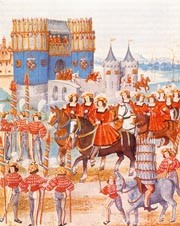
February 24, 1500, Joanna of Castile gave birth to a son at the Prinsenhof of Ghent: Charles de Luxembourg. Very quickly, however, the boy entered the Court of Margaret of York in Mechelen. Later, he was educated by his aunt, Margaret of Austria, the sister of his father, Philip the Handsome, himself the son of Maximilian of Austria and Mary of Burgundy. He remains in Mechelen until his fifteenth year.
His life took then a new turn when, in the Netherlands at the time, January 5, 1515, he is declared of age and therefore recognized sufficiently able to exercise power over these regions. In this task, he has the invaluable help of his aunt Margaret - her father died when Charles was only six years old.
In the main cities of the various duchies and counties, the “Joyous Entry” of a new sovereign is celebrated with all pomp. As Duke of Brabant, Charles is in first instance received solemnly in Brussels and Leuven, then as Count of Flanders, in Ghent. Later, more specifically April 18, 1515, he makes his "triumphal and solemn entry" in the city of Bruges. Holland, Zeeland and Breda are the following on the list to complete its "joyous entries" in different cities of Hainaut, Namur and Luxembourg.
Historical background:
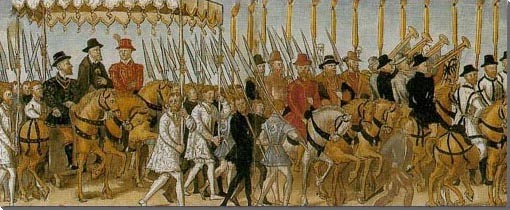
The Joyous Entry was not only a festive tribute and a first contact with the new sovereign, but also a public right event in the ancient feudal state in which representatives of various states swore fidelity and assistance to their new count, duke or king. No right-thinking man - particularly from Ghent - could foresee what complications the oath would result in.
Indeed, at this time, the ancient feudal state seemed restored, the privileges of provincial and local potentates seemed assured. The future looked bright as in the recent past, where dynastic conflicts had led - particularly in Flanders – to a political misery, military and economic in the late 15th century. - 1517: Accession to the throne of the Spanish possessions
-
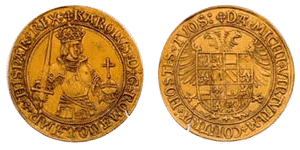
The forecast of a relatively quiet period were soon demolished. And it is faster than expected that the empire of the young ruler would grow, when Ferdinand of Aragon, a widower in 1504 of Isabella of Castile, died January 23, 1516.
The daughter of Ferdinand and mother of Charles V, Joanna of Castile, was not declared fit to succeed his father. It was Charles who would sit on the throne of Spain. In 1517 he made his solemn entry in Spain, after which he was crowned in 1518 as King Carlos Primero.
Count of Flanders, Carlos Primero, is not only Lord of all Low Lands regions, but also of all Spanish possessions and parts of Italy, including Napoli in the south and Milano in the north. - 1519: Charles V becomes Roman Emperor
-
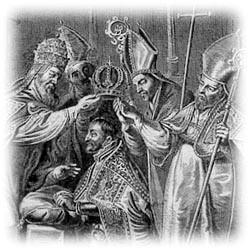
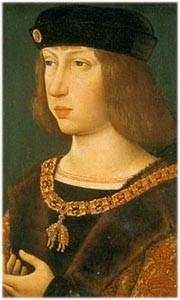
January 12, 1519, the grandfather of Charles, Maximilian of Austria dies.
After an hard electoral confrontation with the king of France, François I, Charles V is elected in Aachen, Emperor of the Holy Roman Empire of the German Nation by the imperial States on 28 June of the same year.
All German territories fall this way under the supreme authority of a prince 19 years old.In less than four years, is the most notable and largest territorial union that is created between the Netherlands, Spain, Italy and the German and Austrian areas.
In 1522, Charles V transferred the territory of Austria-Hungary to his brother Ferdinand, but despite this, the majority of the West-European continent remained entirely under the authority of Charles V.
An empire of such a size soon caused troubles...
- 1521-1522: Revolt in Spain
-
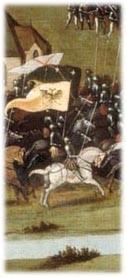
The first authority problems came up in Spain in 1521.
In Castile, with its long historical past, many cities come into rebellion, but Charles V came personally to put things in the right order. In 1522, he arrived in Spain for the second time with his army, and this time with less peaceful intentions. After a bloody military intervention, he promulgates Nov. 2 general amnesty, which in effect restores the royal authority.
This apparent forgiveness is linked to severe repression of the guilties; more than 150 Spaniards, including the Bishop of Zamora, were sentenced to death and executed with a sword.
A first warning of the Emperor... - 1525-1530: Disorders in Germany and Italy
-
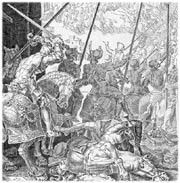
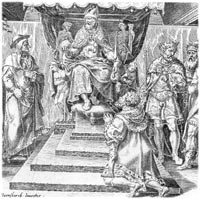
The difficult period in Spain set fire to the powder. In Germany, at the “Diet of Worms” in 1521, a confrontation took place with Luther, after which Charles V promulgated the anti-Lutheran posters. Later in Germany, the great peasant revolt started. It is an understatement to say that the repressive response of the imperial troops was energetic.
In Italy, the relations with Charles V were even more troubled. We mark the year 1527 as that of the famous "Sacco di Roma".
In the war engaged by the Pope and the King of France against the Emperor, German and Spanish soldiers ravage the Eternal City.Historical background
After his problems in Spain, Italy and Germany, it became clear to the still very young Charles that he arrived in a European mess made of numerous contradictions - contradictions because of the large amalgamation of territories and peoples that manifested vividly their differences. But from the beginning, he knew to be very powerful against his opponents.
Charles V. demanded in all his states an absolute obedience to the policy of the monarch and nor the Pope Clement VII, nor the king of France, Francois I, were able to challenge or to prevent a long exercise of a rigid power in his own areas. - 1530: Temporary truce with Francois I and the Pope Clement VII
-
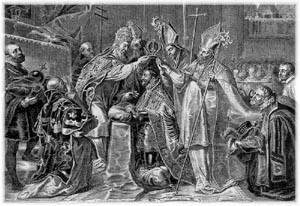
Charles V managed intelligently to expand and consolidate its monarchy. On 3 August 1529, the "Paix des Dames" brings a first fleeting truce with his hereditary rival Francois I, King of France.
February 24, 1530, Charles V is crowned officially by the Church as Roman Emperor. The Pope Clement VII gives the imperial symbols, the scepter, sword and orb to Charles V, then aged 30 and who became an adult man, both internally and externally.Historical background
As with Spanish cities, in the Netherlands, disputes occurred in 1521 with the aldermen of the 'the Franc of Bruges'. At first, there were many to imagine that they would be able to defend all of their ancestral laws and privileges, independently and on a somewhat stubborn way.
After the bloody repression of the revolt in Spain and later also in Italy, the Bruges people had perfectly understood the message. Charles V had become a powerful prince, to whom it was better to tribute and to show submission rather than a stubborn opposition and legal impediments.
Finally, the aldermen decided in 1528 to show their loyalty to the Emperor by giving to his portrait a place in the sumptuous hall of the aldermen of the Franc.But all the cities were not acting this way...
- 1540: The rebellion of Ghent
-
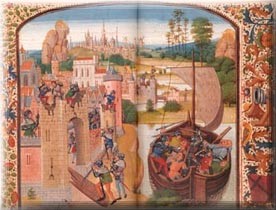
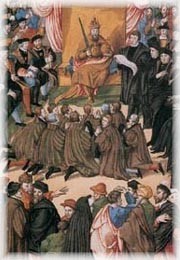
Charles V. conducts impressive campaigns, beyond the seas, but that does not mean that these ambitious operations are like a tranquil river. A very difficult financial situation made him suffer a number of defeats that he could hardly manage. New taxes will have to finance his wars but some cities resolutely refuse to consent to the imperial demands. In Ghent, his reputation is so bad that in the year 1540 the new Governess Mary of Hungary wrote to his brother: "It is here in Ghent that it goes about the fact that Your Majesty is master or servant."
The Ghent population grow his irritation to the extreme when they are plotting an agreement with the King of France. The cup is full.
February 14, 1540, the Emperor comes personally to place them in order: 17 troublemakers were decapitated, an impressive array of eminences are forced May 3 to cross the city in black dress and bare feet, followed by 50 Rebels in white shirt with a rope around their neck, indicating they deserved gallows. The procession leads them to the Prinsenhof, the imperial residence, where everyone put on knees begs the Emperor’s pardon...This is this way that the last urban guilds and guilds of the Middle Ages accepted a centralizing and always expansionist state authority.
- 1531 - 1555: An empire on which the sun never sets
-
There are no brake anymore to the rise of the dazzling power of Charles V. It was under his reign that the American continent will be conquered. Mexico and the Inca Empire follow. At the end of his life, his territory is so extensive, that we can rightly say that the sun never sets on his empire.
Despite his many travels, wars and revolts Charles V had found time to marry Isabella of Portugal, who gave him a son, Philip II, and two daughters, Maria and Joanna. After his abdication October 25, 1555, it was his son who takes his scepter. Charles V, himself, tired and physically diminished, goes to Spain, where he died September 21, 1558 at the Convent of San Jeronimo de Yuste Extremadura. It was one of the greatest emperors that Earth has spawned.
